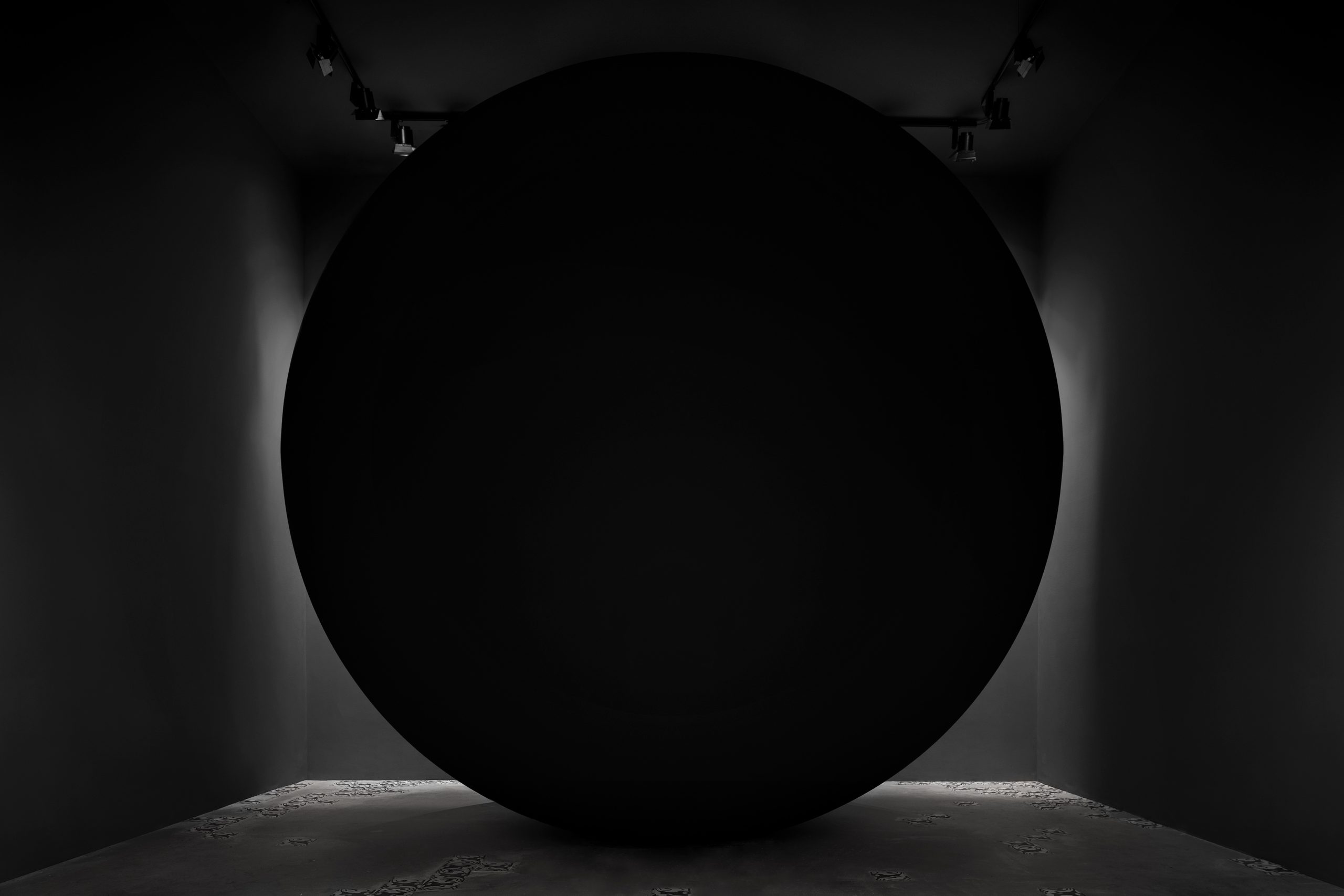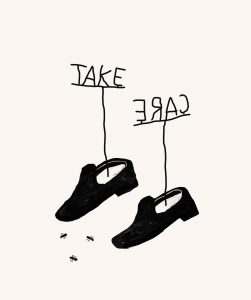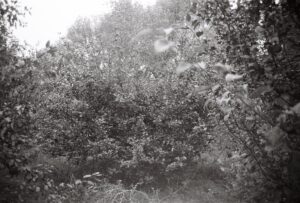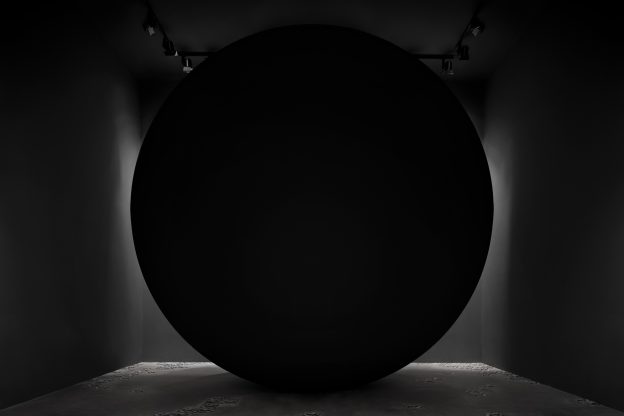
with MONUMENT FOR LOST TIME
an artwork by LARISSA SANSOUR & SØREN LIND
“What has happened has not happened:
thus spoke patience, that the end might not be hurried.”
~ Maurice Blanchot “The Writing of Disaster”
Nothing was going to be the same again, and that’s quite something. As days passed by and became months, bombs kept falling, blitzing the night sky that sheltered our home from—what, now? Glued to the television, watching through bad signal noise live news of the next drop, more than a dozen members of close family lingered in a quarantine that was no longer a quarantine: it was war.
People we knew dropped dead under the sonic shots of sly snipers, as they exposed themselves to the cracks between houses outlining a neighborhood—my childhood—that stood on the rim of a vast cropland. If I were to be asked to locate all the beginnings of my life—not just my birthplace, or first home—the piece of land, known today as Fidanishtja in the town of Mitrovica, in Kosovo, contains them all. For what is, really, more fascinating than the remembered, dreamed, or imagined physical origins [1] of a human soul that, isolated inside of a body, sets off to stand and walk and perhaps, one day, spacewalk too?
Fidanishtja is a field. A large, open agricultural field whose footpaths, flanked by stalks of corn and sunflowers, bristled, through the dog days of growing up, with splintered glass, dung, and rubbish. It’s where the sky was forever within reach and the enchantment that is being a child glistened with unmitigated aliveness. It’s where the immense ignorance that comes with innocence celebrated itself, and the first of May, every year, by mounting countless tires—found, discarded, or stolen in a fever from the nearby bus repair base—into a humongous bonfire that seemed to touch the stars. Billowing, carbon-filled smoke and other chemicals lathered the lungs of wild children filled with laughter, playing around—and with—fire in an unadulterated fit of contagion. While parents, if not present, watered vegetable gardens back home, wondering if we’d be back soon! The rest of the year was not unlike the first of May, even if bonfires were fewer and smaller, while the bus repair base of the transport company Kosovatrans went on with its heavy-duty polluting, as did other industrial sites, lacing the air and playgrounds with toxins that might live on in my lungs now, and in those of countless others. They must.
Fidanishtja, like all other site-specific, psychological archaeologies—everyone’s own first place on earth, where individual destinies are first sealed, and then unlocked into the space we call the world—became also a site of astounding trauma. A trauma not only in the sense of the host of inherently tumultuous experiences of growing up, but pure, objective disaster: war. Just like those of any disaster, memories of wartime are distinct and personal. Even if collective disasters are pervasive, often affecting large swathes of people—and sometimes everyone—at once. The protean nature of memories, however, entangles us in an almost fablelike double movement: we’re both owners of, and total strangers to, what has happened to us. What’s more, we remain at a loss with respect to those happenings and their effect on us (ourselves, the others, the world, the universe). Life events, and disaster-like events in particular, affect our perception of all future events, tingeing them with a sense of uncanny, indeed disaster-like, familiarity. Yet we carry on, cast adrift as we are in space, binging on the anthropogenic pride that is our denial and forgetfulness.
Beneath the occasional triumph of a reformed, educated, or therapized ego, in any adult life lurks the wild child of the most spectacular, reckless bonfires! The smallest unexpected turn of events can quickly reveal to us our present state of affairs, regardless of how personal and site-specific that state is, or how much we knew about it beforehand. Think of fata morgana, the mirages that build up on the horizon when cool air is pushed below and warmer air stands above, refracting light so as to congeal mimetic images of distant objects in eerie, levitated forms. Our intact ego—absolutely essential for any measure of sanity—is like those floating ships on the horizon, a Flying Dutchman that can never make port: portentous, distorted, and awesome. Likewise, any chemical or physical imbalance in the air, just like in the brain—or any corrosive stain in the quality of organized systems, like families, relationships, or states—causes the mirage of intactness to fall flat. A mere drop in temperature, that is, and we become an elevated, even sublime, nebular mess. Like splendid dying stars that, collapsing into themselves, become sites of cataclysmic grace.
Memories, or dreams, of such breakdowns, disasters, or any system failure, provide the eternal, patchy backdrop to our sense of self in the world. We induce it ourselves, just as much as we are inexorably pulled into the end of times. With a combination of luck and circumstances, those memories and dreams that harden with time into defense mechanisms can shield us from what D.W. Winnicott called the fear of breakdown.
Fear of breakdown . . . is related to the individual’s past experience, and to environmental vagaries. At the same time there must be expected a common denominator of the same fear, indicating the existence of universal phenomena; these indeed make it possible for everyone to know empathetically what it feels like when one of our patients shows this fear in a big way.
At its core, and simplified, this fear manifests itself through a compounded inner psychic instability: a dread of what is to come, like the breathtaking symptoms of a common cold gone viral, threatening us with sudden breakdown. But Winnicott also says, and this is crucial, that this fear of breakdown is usually about something that has already happened. Can you, first picture, and then start to rove around with your mind the contours of an experience in your life that you know in your mind and heart that you went through, but you can’t quite nail down its effects in your present moment? On the one hand, tracing back our fears and anxieties to concrete experiences in time is what psychoanalysis is all about, but so is life itself. Life, because every fear, and most eminently, the fear of death, is a string of accumulated fears of breakdowns that have already happened. Put otherwise, a fear of death from falling bombs, say, or collapsing buildings, or even from a virus loose in the air—especially a virus loose in the air—is just that: a fear. Dying is always already inscribed in those three scenarios, should they truly take place and hit us . . . Death is inescapable, even if ‘nothing really happens.’ Fear of death may be distributed differently among us, but we don’t get to choose our share of it. The best we can do is embrace it like a star embraces its nova: shining throughout its life, and after its death has already passed. Winnicott writes:
Little alteration is needed to transfer the general thesis of fear of breakdown to a specific fear of death. This is perhaps a more common fear, and one that is absorbed in the religious teachings about an after-life, as if to deny the fact of death.
As Ernest Becker paraphrases Aristotle in his book The Denial of Death, luck is when the guy next to you gets hit with an arrow. That is to say, luck is fickle. But luck, that bittersweet feeling of having ourselves escaped a disaster or death for once, links up with the fundamental selfishness of human beings, according to Becker. “If we care about anyone it is usually ourselves first of all.” Not that we’re to blame for our selfishness at the heart of our feeling lucky, Becker writes. It’s just that, in reaping the benefits of our luck, we always do so at the cost of the other.
A memory that I come back to again and again is that of myself, aged eleven, rushing out into the dark with the entire family through the door of the improvised ambulatory clinic—a room at home where my mother received patients—in the final, ugliest moments of the war in Kosovo, in March 1999. We were escaping under the intermittent flashes of falling bombs, as news came around that the killer army was breaking through houses and evicting everyone. As we all crammed into the exit door—a feverish stampede—I kept searching for my missing shoe, as I tried tying the laces of the other one. My father shouted at me, “Forget the damn shoe and get out, quick!”
In the street, I remember trying to locate the killers with my eyes, to see the face of evil (where is it, I must have been thinking). I kept turning my head around as if to want to gobble all of the outside at once with what must have been petrified eyes. But I do not know what I looked like at that moment. The night, the chaos, and what quickly became a sea of people—friends, neighbors, and strangers—looked like starcrossed millipedes. Through a divine action cut, next we’re all walking through Fidanishtja, faster in memory than in reality, heading west out of town. Older people were being pushed on wheelbarrows, my seven-months pregnant mother, brother, and sister by my side, as countless fugitive souls marched through the cropland, zombie-like.
Sniper bullets whooshed from adjacent hills on the right, as we were being chased off from the left. Upon arrival at a nearby village, after hours of walking (or how long do these things really last?), the break of day began revealing the true features of what was happening. We—a we that was breaking off by the hour—spent a week or so in the village, trapped, ambushed, quarantined, and besieged, the sky on fire; I wouldn’t see—or know anything about—my father for the next three months.
Of this point of the disaster, I have two memories: first, despite appeals not to, the following day my mother decided to embark on the same path back home, all the way through the cropland, to bring back to the village her abandoned stacks of medication, badly needed for the wounded. She walked the same diabolical path over and back again, returning with medicine in her hands, pregnant, and a fierce smile (her cheeks were red). “I do not know how I am alive, kids, but here I am,” she said. “I was faster than the whoosh of sniper bullets, I guess!”
My second memory, there and then, is the cacophony of adults repeatedly asking one another: “is he alive?”, “is she alive?”, “are they alive?”, until a week or so later brought our turn at the top of the exodic waiting list, and we finally embarked on a bus, and then a train, to Albania. Through another divine action cut, the next thing I remember is myself and two siblings in Tirana, generously hosted by a family we didn’t know. The refugee time became a portal to another space-time continuum. I spent entire days walking across the town with my heavily pregnant mother, as she carried her bump, and with divine perseverance kept searching for clues about her missing husband, our father.
This disastrous rush of blood to the head, and the violent plucking of human lives from their homes that is the war, meant that at age eleven I had waved goodbye, without gesture or utterance, to Fidanishtja, my friend of friends, the cropland—that elusive playground—containing what then were all of my good memories. The endless stargazing, the bonfires, the exposure to all kinds of toxins, the long evenings away from home only to come back filled with scratches, and with the occasional bloodlet. The rough-and-tumble play, with its erotic transgressions, the indomitable desires and, what psychoanalyst Sidney H. Phillips calls the “tantalized inner world of longing”, gone. (Forever?) An end, not with an oh, or a whimper, but with a bang.[1]
The word “disaster” means “ill-starred event” (from the Italian disastro), formed by the Latin compound dis– (expressing negation) + astro (“star” from Latin astrum). According to the Online Etymology Dictionary, dis– is a word-forming element of Latin origin meaning lack of, not; opposite of, do the opposite of; apart, away; asunder, in a different direction, between. While astrum is of ancient Greek origin, ἀστήρ (astḗr)—meaning star, planet, celestial body—brings us the words “astronomy” and “astrology.” Moreover, the ancient Greek equivalent of the Latin dis– is δῠσ– (dus-/dys-) meaning bad; hard; unfortunate (as in dysentery = bad bowels). Other sources characterise the Latin dis– as also meaning, without; separate; or expel.[2]
Disaster can mean different degrees and manifestations of an unfortunate event with great damage or loss, resulting from all kinds of human and non-human causes. For ancient peoples, in particular, disaster meant stars were to blame for a wide range, perhaps even the whole gamut, of unfortunate events that suddenly befell them. Astronomically speaking, and most poignantly, a disaster can be, at least etymologically is, the word to describe what happens to dying stars: they disintegrate, collapse into themselves, and cause supernovas. Further stretching the origin of the word, a disaster is also the havoc wreaked by space weather caused by the Sun’s outermost layer, the corona, which produces solar winds that whoosh all kinds of particles across the solar system. Some of these objects often puncture our Earth’s magnetic field causing, ideally, only auroras borealis.
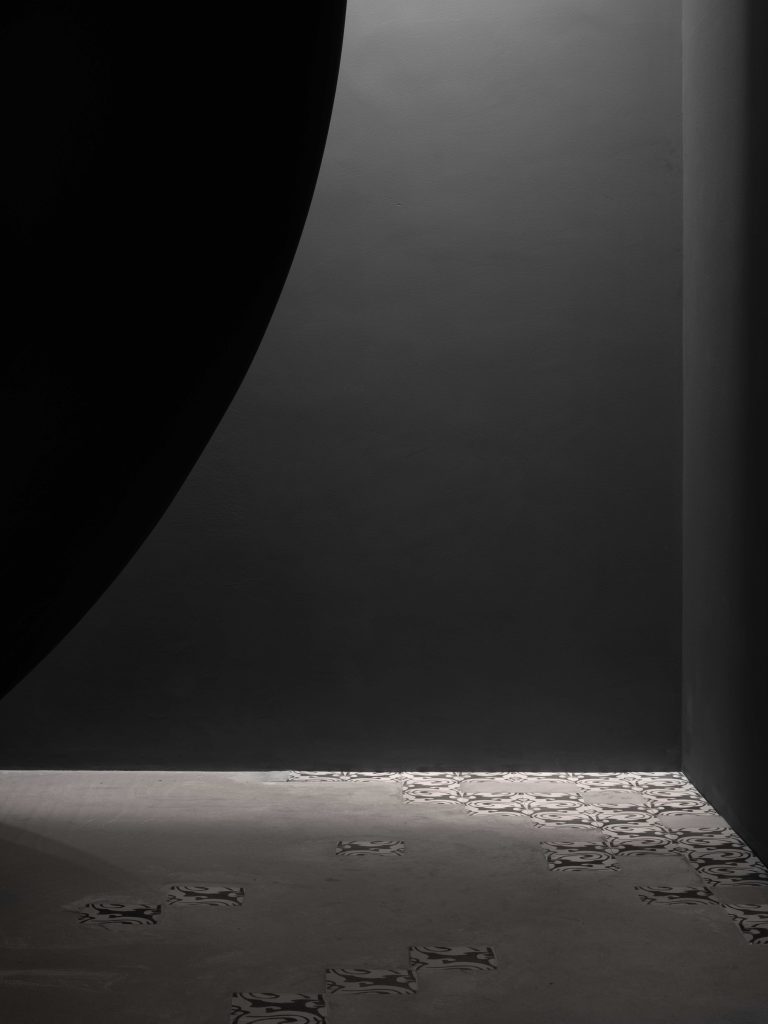
Astrologically speaking, humans on Earth are said to be ‘under the weather,’ moody, excessive, or stripped of their bearings, sick; they make wrong, hasty, or impulsive, decisions about their lives and those of others in periods when, for instance, Mercury is retrograde. The pagans uttered conversational oaths referencing an observable, imagined, or believed, celestial order, such as “by Jove” (Jupiter), or “by Zeus” (Olympic god), or, as Socrates is said to have oathed, “by the Dog,” a reference to Sirius, the brightest star in the night sky, which is a name derived from the ancient Greek word Σείριος (Seirios, meaning “The Scorcher”). Sirius is also known as the Dog Star, and its effects on Earth were believed to cause dogs to go wild during the hot and languid summer days, known as the dog days.
A sense of the disastrous is inscribed in the meaning of idiomatic phrases such as ‘to head south,’ or the Spanish perder el norte (literally “to lose one’s north”). Both meaning a sudden turn of events for the worse, or a getting lost. Disaster can also mean to be separated from a star, or be expelled from an order of things, from a stable unity or a system (like a home, or a place, or a strong sense of both). Existentially disastrous seems to have been the inner state of Chilean poet Nicanor Parra in his poem “La Trampa,” “Because, for reasons hard to set forth / I began sliding automatically down a sort of inclined plane / my soul lost altitude like a punctured balloon.” So many of those etymological characterizations of dis-aster, including the poetic image of a punctured balloon (reminiscent of lung failure) can come to depict supremely tragic moments, indeed death, for living systems thrown into various forms of disarray.
The lives lost at the mercy of a co-pilot who locked himself in the cockpit of Germanwings Flight 9525 kamikazing in the Alps is a supremely tragic example of breakdown, both in the mind, and loss of the guiding star, in the time-space continuum. Estrellado: the Spanish word for a crash against a hard surface, a violent break, a tearing to pieces, including to fill/cover with stars is estrellar, from Latin, stellāris, belonging to, or relative to the stars. Indeed, the word means to make/cause anything to look like stars in the sky, as in: scattered, scrambled, splintered.
“There is a man / who loves you, lost in the enveloping night / who suffers as an earthworm enamored of a star,” says the protagonist of Victor Hugo’s Ruy Blas. During a recorded event between French philosopher Jean Pierre-Dupuy and Slavoj Žižek, Dupuy engaged in a curious, if cursory, investigation of the etymological kinship between the words disaster and desire. If disaster is to lack, or be without, a star, a disappearance of the star, desire is a derivative of the Italian desiderare (of Latin origin, de: down from, and –sidus: heavenly body, star) meaning to long for, to wish for, to want, to await what the stars will bring. As Dupuy adds in passing, “desire means absence of the star, we’ve lost the star, that’s why we desire.” Indeed, as anyone can attest from experience, desiring (say, falling in love, lusting, longing, eating or shopping, even ambitiousness) depletes us. Yet, as we keep looking for objects to fulfill us, we can’t help but enjoy this never-ending search at our own cost. The cost being a surrender to the proliferation of stand-in objects promising a satisfaction that perhaps would be best described as a mirage of faraway, so close. Being thus metonymically inscribed in the signifying chain—linguistic units in the form of sounds and words that collude in a quantum entanglement as we speak—the objects that we long for and pursue in our life can also be thought of as forming a psychic constellation of shooting stars. In our head.
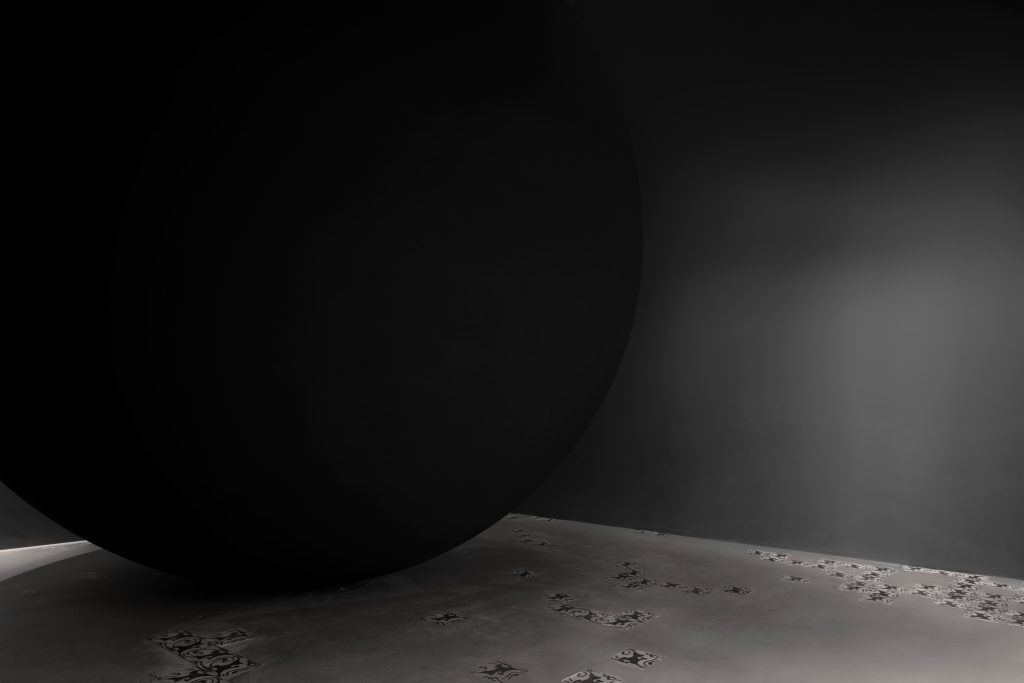
Dupuy’s presentation, entitled “Lacan’s Twelfth Camel and the Collapse of Self-Transcendence,” is where he introduces the theory of predestination, the basis of his concept of “enlightened doomsaying,” a ruse which “consists in pretending we are the victims of fate, while keeping in mind that we are the sole cause of what happens to us.” A systems thinker and philosopher, rather than a New Age guru, he writes in his book The Mark of the Sacred, “enlightened doomsaying invites us to make an imaginative leap, to place ourselves by an act of mental projection in the moment following a future catastrophe and then, looking back toward the present time, to see catastrophe as our fate—only a fate that we may yet choose to avoid.” Perhaps, similarly, we can only find fulfillment through desiring if we mentally project what we have right now as our future fulfillment and then, looking back at our present life, see what we have right now as our fate—only a fate that we have chosen, or can still choose, to embrace. Or avoid.
Dupuy’s proposed ruse is meant to equip us with a capacity (a philosophical attitude) to genuinely embrace the prospect of catastrophe. Urging us to mentally project ourselves into a pretend disaster, to live as if it has already happened—so that we can then choose to avoid it—this capacity is not unlike Winnicott’s aim to describe a way of relieving neurotics, indeed perhaps psychotics too, from their fears, and actual mental breakdowns, through a psychoanalysis that acts based on:
the possibility that the breakdown has already happened, near the beginning of the individual’s life. The patient needs to ‘remember’ this but it is not possible to remember something that has not yet happened. . . The only way to ‘remember’ in this case is for the patient to experience this past thing for the first time in the present, that is to say, in the transference.
Just like Dupuy’s ruse of enlightened doomsaying, intended to awaken us in the present to a future disaster in the world, a similar “imaginative leap”—in the direction of the past, rather than future—seems to be necessary for Winnicott’s own clinical “ruse” used in analysis of the fear of breakdown in his patients. The experience in the present of the full effects of “an unthinkable state of affairs” originating in the past, manifests first as an “emptiness” lurking in the mind. This emptiness produces in turn the fear of breakdown, which then can lead to a lifting of the veil behind which the missing/missed experience is comfortably, but also disastrously, hidden.
Desire is a relation of being to lack, according to Lacan, rather than to a specific object. Moreover, “this lack is beyond anything which can represent it. It is only ever represented as a reflection on a veil.” It follows, then, that “desire is desire for what is missing and has always been missing.”
If one considers the thump of desire as a pining away, or its relation to lack as a longing for what is missing, without ever knowing what is it we’re so doggedly after, we can begin to see how, when it occurs, a disaster, too—like death, war, a mental breakdown, or a pandemic—is a result of an overfill, an accretion of tensions, an inexorable pull, a contagion always already loose in the world.
On August 11, 1999, the last total solar eclipse of the millennium gripped the imagination of many, becoming the most widely viewed solar eclipse in history. We were still refugees in Albania, and for us too this was a unique event as we gawked at the sky with fascination, awaiting what the stars would bring.
In the meantime, my father had found his way out of the war, having lost his way in the mountains, separated from a group of thirty-two fellows escaping the last, deadliest, throes of the war. Twenty-eight of that group are lost to this day, not one single clue exists about their fate, as about the fates of thousands of others that disappeared in the war.
My father joined us in Tirana at the end of May, just as I turned twelve. Upon his return I went to the market to buy my father a pair of shoes. With a sense of duty even, as my parents remind me to this day. Did I unconsciously want to make up with my father for foolishly holding back the entire family for a few eternal moments searching for my missing shoe that day, back home in Mitrovica during that night of falling bombs, as the killer army approached, expelling us from our homes and exposing us to death? I’d like to think so.
My mother had already given birth on the fifteenth of June, just three days after the war was officially over, and the same day we were supposed to embark on a ship to Italy, with tickets in our hands, to immigrate, forever!? However, the birth of our youngest brother, the father’s return, the end of the war, and a general yearning to go back home, coupled with fear of irreversible loss of contact with homeland, ended up preventing us from pursuing the other equally powerful desire to immigrate.
At just under 11:00 o’clock, August 11, the Sun’s corona came into full view, a ring of fire. In the end, for Blanchot: “The disaster takes care of everything.”
[1] In T.S. Eliot’s poem “The Hollow Men,” written during a nervous breakdown in 1925, the “hollowness” Eliot refers to can be considered in the context of Winnicott’s discussion in Fear of Breakdown of the state of “emptiness” characterising the fear in question.
[2] “What attracts us to etymology is its unreasonable part more than what it explains: we are interested by the form of enigma that it preserves or doubles as it deciphers,” writes Maurice Blanchot in The Writing of the Disaster. Interrogating the notion of disaster, and even the premise of the notion itself, he writes “. . . we are insidiously (inevitably) subject to etymological clues which we take for proofs and from which we draw philosophical conclusions that secretly influence us. Such is the danger, indeed the abuse which brings into doubt much more than the recourse to etymology.”
Ayto, John. Dictionary of Word Origins. Arcade, 2011.
Becker, Ernest. The Denial of Death. Free Press, 1973.
Blanchot, Maurice, and Ann Smock. The Writing of the Disaster. Nebraska, 2015.
Centre for Research in Modern European Philosophy. “Concept and Form: The Cahiers Pour L’Analyseand Contemporary French Thought.” Desire – Cahiers Pour L’Analyse, cahiers.kingston.ac.uk/concepts/desire.html#_note18. Accessed 8 Apr. 2020.
Cresswell, Julia. Little Oxford Dictionary of Word Origins. Oxford University Press, 2014.
“Disaster.” Etymonline, www.etymonline.com/word/disaster. Accessed 8 Apr. 2020.
Dupuy, Jean-Pierre. A Short Treatise on the Metaphysics of Tsunamis. Michigan State University Press, 2015.
Dupuy, Jean-Pierre, and Malcolm B. DeBevoise. The Mark of the Sacred. Stanford University Press, 2013.
Eliot, T. S. “The Hollow Men.” Collected Poems 1909-1962, Faber & Faber, 2002, pp. 77-82.
“Fidanishtja.” Wikimapia, uploaded by Qylaxhiu, 2009, wikimapia.org/15552996/sq/FIDANISHTJA#/photo/1121174.
Hugo, Victor. Ruy Blas. Four Plays, translated by Richard J. Hand, Methuen Drama, 2010, pp. 287-488.
Lacan, Jacques. The Ego in Freud’s Theory and in the Technique of Psychoanalysis: 1954-1955. Norton, 2010.
“Memories of the War in Kosovo 20 Years on.” YouTube, uploaded by Associated Press Archive, 23 May 2019, www.youtube.com/watch?v=OynxLEofVSQ.
Parra, Nicanor. “The Tramp.” Poems and Antipoems, translated by W.S. Merwin, New Directions, 1967.
“PCPH Presents: Slavoj Žižek and Jean-Pierre Dupuy at Portland State University, October 31, 2014.” Youtube, uploaded by Portland Center for Public Humanities, 5 Dec. 2014, www.youtube.com/watch?v=D3ipFXii1XY.
Phillips, Sidney H. “The Overstimulation of Everyday Life: I. New Aspects of Male Homosexuality.” Journal of the American Psychoanalytic Association, vol. 49, no. 4, 2001, pp. 1235–67.
Solnit, Rebecca. A Paradise Built in Hell: the Extraordinary Communities That Arise in Disaster. Penguin Books, 2010.
Winnicott, Donald W. “Fear of Breakdown.” The Collected Works of D. W. Winnicott, 2016, pp. 523–32.
MONUMENT FOR LOST TIME (2019)
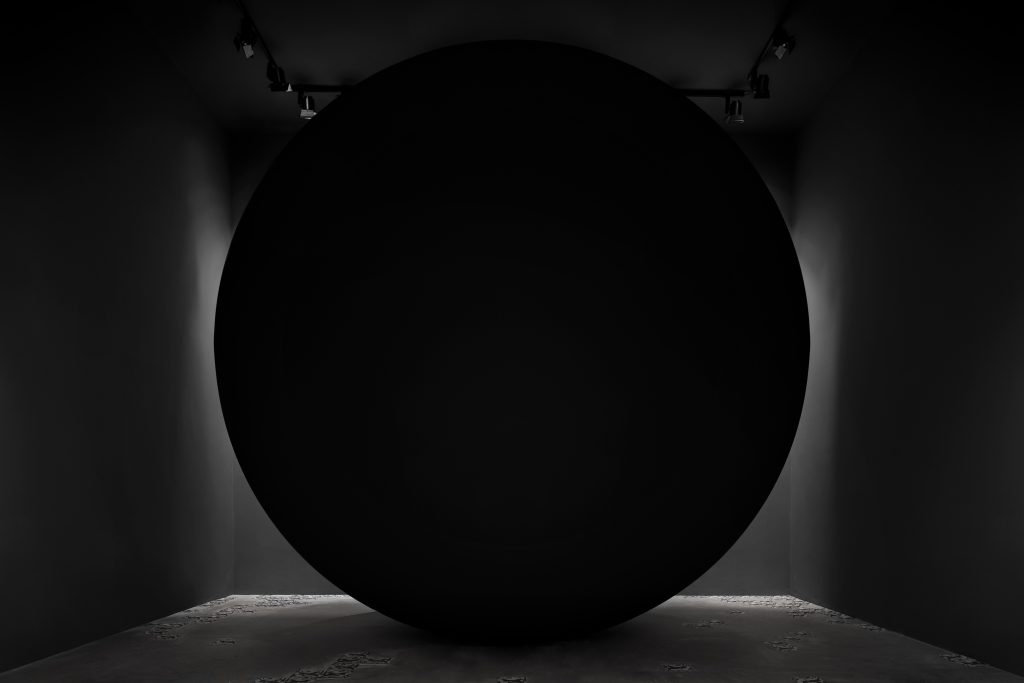
The sculpture MONUMENT FOR LOST TIME takes a psychological object from the film In Vitro and converts it to a physically imposing fact – a large fibreglass sphere, 480cm in diameter. The sphere is painted in Black 2.0, a shade so black that no light is reflected. This turns the sphere into an optical illusion, rendering it virtually absent, yet at the same time intimidatingly present and overwhelming.
In Vitro is a 2-channel Arabic-language sci-fi short filmed in black and white. It is set in the aftermath of an eco-disaster. An abandoned nuclear reactor under the biblical town of Bethlehem has been converted into an enormous orchard. Using heirloom seeds collected in the final days before the apocalypse, a group of scientists are preparing to replant the soil above. In the hospital wing of the underground compound, the orchard’s ailing founder, 70-year-old Alia, is lying in her deathbed, as 30-year-old Alia, comes to visit her. The talk between the two scientists soon evolves into an intimate dialogue about memory, exile and nostalgia.
The sphere appears in the film as an out-of-place object in the character Alia’s imagination and also features in the dialogue between the two women. In a discussion about temporality, they address the suspension of the Palestinian psyche between past and future, and the absence of a viable present, becoming an embodiment of inherited trauma. By not reflecting any light and appear as a voluminous vacuum, the sculptural sphere sits outside time and space.
SOKOL FERIZI writer
Sokol Ferizi b.1987 in Mitrovicë (Kosovo) is a writer, poet, and translator, living and working in Berlin. His work includes a book of poems, In a World Without Germany We Could Be So Good Together, and contributions to magazines such as Starship, Havenot, The Moth, and 212, as well as zines such as Lirindja, Kushtetuta, and Lamella.
LARISSA SANSOUR artist
SØREN LIND artist/writer
MONUMENT FOR LOST TIME (2019): Installation images from the 58th Venice Biennial, Danish Pavilion. 480x480cm, fibreglass/ steel/ tiles/ cement/ sound.
Composer: Mons Niklas Schak
Photographer: Ugo Carmeni
© Copyright for all texts published in Stillpoint Magazine are held by the authors thereof, and for all visual artworks by the visual artists thereof, effective from the year of publication. Stillpoint Magazine holds copyright to all additional images, branding, design and supplementary texts across stillpointmag.org as well as in additional social media profiles, digital platforms and print materials. All rights reserved.
